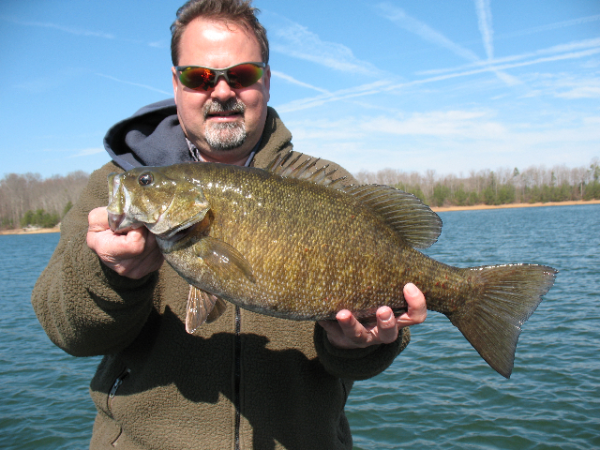Reservoir Smallmouth Bass Season Around the Corner |
| By Lee McClellan, Kentucky DFW from The Fishing Wire Reservoir smallmouth anglers are a weird lot. They dangle tiny little hair jigs under bobbers in air so cold ice forms in the guides of their rods. They think the best late fall fishing days feature leaden, low skies, light rain and highs in the 40s–miserable for them, great for smallmouths.The record heat wave of early October is now a memory. The bracing morning air and cooler, longer nights signal to many bass anglers the fishing season is about done for the year. For reservoir smallmouth anglers, however, the season is just beginning on lakes such as Lake Cumberland, Laurel River Lake and the home of the world record smallmouth bass, Dale Hollow Lake. Mid-October through late spring is the best time of year to catch large smallmouth bass in these reservoirs. The fish are in great body condition at this time of year and the smallmouth populations in these lakes are robust and stable. The smallmouth bass in Lake Cumberland, in particular, are in spectacular condition right now. They look like footballs, with nearly bursting bellies stuffed with threadfin shad and alewives.Water temperatures at these lakes are in the low 70s and soon will fall into the high 60s, the beginning of perfect temperatures for smallmouth bass. “You can catch smallmouths right now, no matter what time of day,” said Chad Miles, host of the Kentucky Afield television show. “You have a good chance to catch them on topwaters, as well as jigs. We are still a little ahead of the peak for smallmouths, but it is on the way.”Miles is an expert smallmouth angler who fishes Dale Hollow Lake regularly from late fall through spring.On some early fall days, smallmouths herd baitfish against the surface of the lake and rip through them, a process called the “jumps” by anglers. The churn created by these feeding fish looks like the top of an old school coffee percolator. A silver casting spoon is one of the best lures for jump fishing because you can cast it into the next county. Blade baits such as the Silver Buddy also work well in this situation. Cast these lures into the jump and let them flutter down. The smallmouths usually hit the lure immediately. The Ned rig is one of the relatively new lure styles catching many reservoir smallmouth bass on these lakes. It consists of using a 5-inch Senko-style soft plastic stick bait cut in half or one of the 2.75-inch Finesse TRD baits designed specifically for the Ned rig. Thread the fat end of these soft plastic lures toward the head of the mushroom-shaped lead heads designed for this technique with the hook exposed. Cast these on points or in the middle of small cuts along the main lake or major creek arm on these lakes. Allow the lure to settle to the bottom and let it sit there for a few seconds, a technique called “deadsticking.” Slowly crawl the lure on the bottom for a few feet and let it deadstick again. This presentation drives reservoir smallmouth bass crazy and people with limited fishing experience can catch fat smallmouths on the Ned rig. Anglers on Lake Cumberland using the Ned rig have already been catching nice smallmouth and spotted bass for several weeks. Curly-tailed grubs rigged on plain ball-shaped leadheads still work remarkably well for reservoir smallmouth bass. White, pumpkinseed, green pumpkin and black grubs all produce at this time of year.Jigs with smaller heads and shorter, less dense silicone skirts or 1/4-ounce hair jigs in combinations of green, brown and orange work well for smallmouth bass in these reservoirs. A smallmouth angler would rarely make a mistake by choosing a black jig. Fish these lures across or along channel drops and down the sides of points in a rhythmic retrieve. Swimming jigs or curly-tailed grubs over submerged humps also fool reservoir smallmouth in fall.Jigs and grubs are good lure choices to fish these areas, but faster moving baits also score. “I fish a tailspinner often in late October and early November on points,” Miles explained. A tailspinner is an old-school lure with a leadhead trailed by a single spinner blade and a dressed treble hook.Cast the lure beside the point and allow it to flutter down to the smallmouths staging on the point. They usually hit this lure on the fall, so watch the line intently for any unusual movement. If you see a jump in the line or it goes slack, set the hook. Fluorocarbon lines in 6- to 8-pound test work really well for fall reservoir fishing when fished on medium-power spinning gear. These lakes possess some of the clearest water in Kentucky and the stealth offered by fluorocarbon line produces results. Fluorocarbon lines also stretch less, allowing for better hook sets, and their density increases sensitivity. “When the water gets colder, I use heavy football jigs fished really slowly,” Miles said. He will use up to a ¾-ounce jig for this style of fishing and employs baitcasting equipment and 12-pound fluorocarbon line.Serenity, especially on weekdays, is an added benefit of fall and winter smallmouth fishing. You rarely see other boats on the water, making the experience all the better. Author Lee McClellan is a nationally award-winning associate editor for Kentucky Afield magazine, the official publication of the Kentucky Department of Fish and Wildlife (This is the fourth installment of a series of articles titled “Fall Fishing Festival,” profiling the productive fishing on Kentucky’s lakes, rivers and streams in fall. Archived articles in this series are on the department’s website at www.fw.ky.gov.) |
